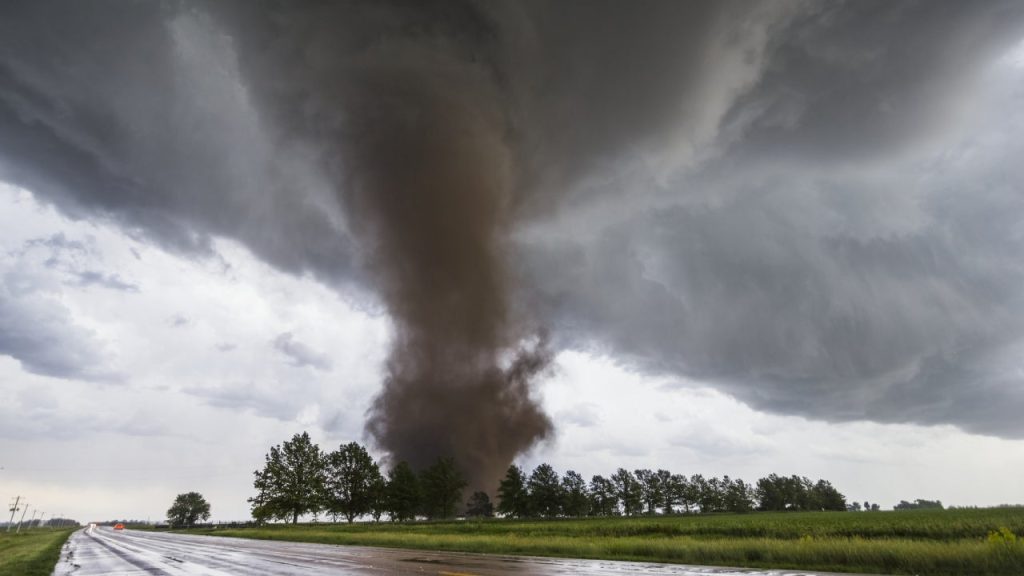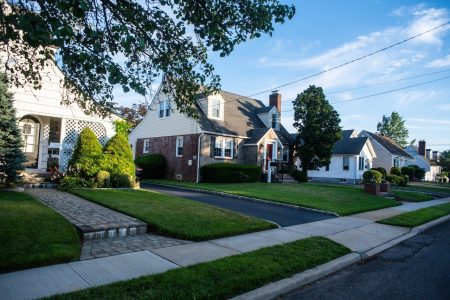Depending on where you live, tornadoes can be a major concern. Data from the Insurance Information Institute (Triple-I) and the National Oceanic and Atmospheric Administration (NOAA) found there were a total of 1,423 tornadoes in 2023, up from 1,240 in 2022. Not only were there more tornadoes last year, but the storms were also more deadly. The same report found that there were 83 tornado-related deaths in 2023 — more than three times the number of casualties recorded in 2022.
If you live in one of the worst states for tornadoes, you are likely familiar with the basics of tornado prep: secure your windows, keep your trees trimmed, get your roof checked, etc. But, making sure your home insurance policy is up to snuff ahead of tornado damage can also be a major help. By ensuring your policy offers sufficient coverage, you may be better prepared to weather the storm.
The worst states for tornadoes ranked
A tornado usually forms after a thunderstorm, when humid air inside thunderclouds rises while cooler air falls. This creates a spinning cyclone of air that, when flipped vertically, becomes a tornado. Tornado strength is measured on the Enhanced Fujita (EF) Scale, which gauges three-second wind gusts and related damage. EF0 storms have gusts as low as 65 mph, while EF5 tornadoes have wind speeds of 200-plus mph.
Expectedly, tornadoes are not spread evenly throughout the country; some states are significantly more vulnerable to tornado damage than others. Illinois, Alabama, Colorado and Texas saw the most tornadic activity in 2023.
What are the 10 worst states for tornadoes?
The table below lists the worst states for tornadoes ranked and the average cost of home insurance compared to the national average, which is $2,230 per year for a policy with $300,000 in dwelling coverage.
| Illinois | 136 | $2,189 | -$41 |
| Alabama | 101 | $2,745 | +$515 |
| Colorado | 89 | $3,124 | +$894 |
| Texas | 89 | $3,726 | +$1,496 |
| Mississippi | 81 | $2,820 | +$590 |
| Nebraska | 81 | $5,249 | +$3,019 |
| Iowa | 73 | $2,012 | -$218 |
| Georgia | 58 | $1,945 | -$285 |
| Ohio | 56 | $1,188 | -$1,042 |
| Tennessee | 53 | $2,410 | +$180 |
Of the 10 worst states for tornadoes, six have home insurance costs that are higher than the national average. The added cost of home insurance in these regions may be tied to the greater risk of tornado damage, but that might not be the only force at play. Other natural disasters can affect the cost of home insurance in a particular state, as well. Plus, state insurance regulations can factor into the equation.
The states with the fewest tornadoes
While tornadoes occur in all 50 states and Washington, D.C., several states experience minimal tornadic activity in an average season. These states recorded no tornadoes in 2023:
Additionally, these states recorded three or fewer tornadoes last year:
While these states record relatively few tornadoes on average, each season differs. Even states that aren’t considered to be high risk for tornadoes can experience dangerous convective storms that spawn tornadoes and cause widespread property damage.
Which states are in Tornado Alley?
Tornado Alley usually refers to states in the Great Plains, such as Kansas, Oklahoma, South Dakota, Iowa and Nebraska. The northern tip of Texas is typically included, too. As the name implies, this region sees an above-average number of tornadoes each year.
Even if you own a home outside of Tornado Alley, that doesn’t mean you’re completely in the clear. Tornadoes are also common in Dixie Alley, which stretches across parts of the southern United States. Arkansas, Louisiana, Mississippi, Tennessee, Alabama, Georgia and parts of Kentucky make up the bulk of Dixie Alley.
That said, Tornado Alley and Dixie Alley are not official meteorological designations, and tornadoes can still wreak havoc outside these areas. The Midwest, in particular, is experiencing an uptick in tornadoes. A study by the National Severe Storms Laboratory (NSSL) showed that from 1979 to 2017, the number of tornadoes per year has been steadily increasing in Illinois and Indiana (among other states). Another study in the Journal of Applied Meteorology and Climatology reports increased tornado activity in the Midwest and Southeast.
The NSSL also notes that tornado hotspots tend to move depending on the season. In the cooler parts of the year, the Southeast experiences more tornadoes than the rest of the country, but that shifts to the South and Central United States in the spring. The Northern Plains and Midwest experience a heightened risk in the summer.
Does homeowners insurance cover tornadoes?
In some cases, home insurance will cover tornado damage to the structure of your home, its outbuildings and your personal belongings. Your policy will also likely cover damage from fallen trees that are blown onto your home during a storm. However, that may not be the case for all homeowners. Policies can vary from company to company, so some storm-related damage could be limited or excluded altogether.
Further, your home insurance policy might not offer enough coverage if you live in one of the worst states for tornadoes. In some high-risk counties in Texas, wind damage is not a covered peril. To be financially protected in the event of tornado damage, you would need a separate wind policy or an endorsement. Or in places like Florida, you may have a “named storm” deductible, which means a separate deductible applies if your home is damaged by hurricane winds or a tropical storm.
In addition to heavy winds, the intense convective storms that spawn tornadoes often cause floods. Flood damage is not covered by standard homeowners insurance. In order to be covered for flooding, you will need to purchase a separate flood policy.
The bottom line is that home insurance policies vary in coverage, so it’s a good idea to review yours with an insurance professional before tornado season begins.
How home insurance can help you financially recover from a tornado
Your home insurance policy can help you financially recover after a natural disaster like a tornado. An insurance contract transfers the bulk of the financial risk of rebuilding or repairing your home to an insurance company. That way, if your home is completely destroyed or seriously damaged, you won’t need to pay for everything out of pocket.
Shannon Martin, licensed agent and Bankrate analyst, points out that protecting the financial investment you’ve made in your home could require revisiting the types and amounts of coverage you have in place if you haven’t given thought to your policy in recent years.
Inflation has caused the cost of hardware and building supplies to remain high — they cost 24 percent more now than in February 2020. For homeowners, this means if your dwelling limit is still the same as it was then, you are underinsured. Speak with your agent to see if your home policy automatically accounts for inflation and if your coverage has kept up with the unprecedented rise in inflation that we have experienced over the last few years.
— Shannon Martin, Bankrate Insurance Analyst
Raising your dwelling coverage limit may not be cost-effective for all homeowners, though. According to average rate data from Quadrant Information Services, a policy with a $350K dwelling limit costs around $260 more per year than a policy with a $300K limit. Depending on your insurance company, it may be cheaper to purchase an extended dwelling replacement endorsement in lieu of raising your coverage limits. This endorsement allows you to increase your dwelling coverage limit by a certain amount, usually between 10 and 30 percent, for better financial protection in the event of major damage or a total loss.
Prepping your home for tornadoes
In addition to making sure your home insurance covers you in the event of a tornado, there are some things you can do before and after a storm to mitigate your risk and minimize damage. The following tips can help you prepare for a natural disaster by physically safeguarding your home and belongings. If you live in an area where tornadoes are common, you may want to:
- Strengthen your garage by reinforcing it with vertical bracing.
- Reinforce your roof with hurricane clips.
- Secure your windows with plywood and clips.
- Remove branches and trees on the verge of breaking or overhanging your roof.
- Keep important paper records in a secure location in waterproof containers.
- Invest in a storm-proof safe room.
These preparations could make an enormous difference should a disaster strike. If the worst does happen, having a detailed home inventory, including “before” pictures of valuable belongings and the inside and outside of your home, can be helpful if you need to file a property insurance claim. Such an inventory should be stored online (as opposed to on your hard drive) or on a flash drive in a waterproof container.
Frequently asked questions
-
Technically, you cannot shop for a vehicle tornado policy. To financially protect your vehicle from tornado damage, you would need to carry comprehensive coverage on your car insurance policy. Also called other-than-collision insurance, comprehensive car insurance covers damage that results from anything other than vehicle impact like damage from a fallen tree or hail.
-
If your home is not safe to inhabit after a covered claim — like if a fire tears through it or a tree falls on the house — your home insurance policy can help cover things like a hotel room, meals out, pet boarding and other necessary expenses up to your policy limit. This is called loss of use coverage.
-
Data from NOAA show that 2004 was the worst year for tornadoes in the United States, with 1,817 confirmed storms.
-
On average, Texas and Kansas see more tornadoes than any other state. From 2003 to 2022, Texas experienced an average of 124 tornadoes per year, while Kansas had fewer at 87 per year.
-
Bankrate utilizes Quadrant Information Services to analyze June 2024 rates for all ZIP codes and carriers in all 50 states and Washington, D.C. Quoted rates are based on married male and female homeowners with a clean claim history, good credit and the following coverage limits:
- Coverage A, Dwelling: $300,000
- Coverage B, Other Structures: $30,000
- Coverage C, Personal Property: $150,000
- Coverage D, Loss of Use: $60,000
- Coverage E, Liability: $500,000
- Coverage F, Medical Payments: $1,000
The homeowners also have a $1,000 deductible, a $500 hail deductible and a 2 percent hurricane deductible (or the next closest deductible amounts that are available) where separate deductibles apply.
These are sample rates and should be used for comparative purposes only. Your quotes will differ.
Read the full article here
















